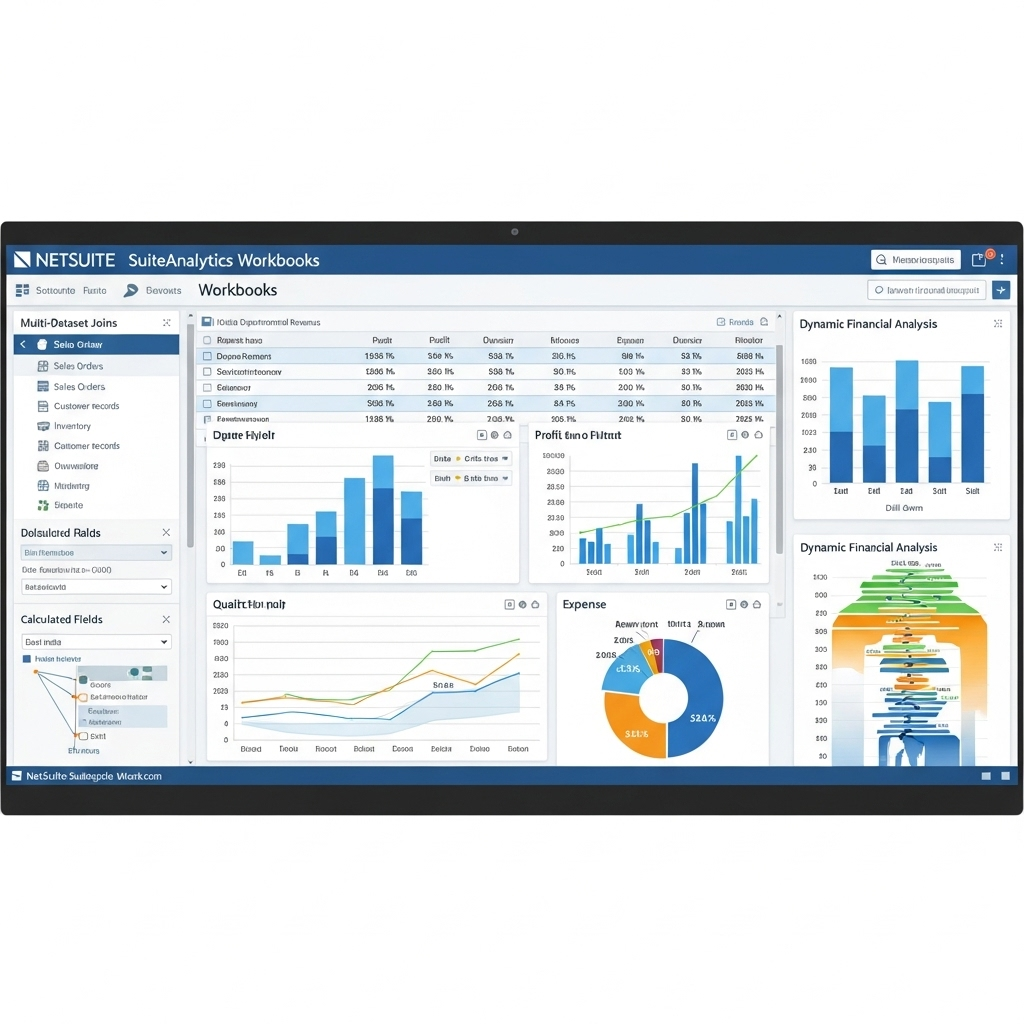
Table of Contents
The Evolution of Native Analytics within NetSuite
NetSuite’s Saved Searches have long been the workhorse for extracting data and basic reporting within the platform. They are powerful, certainly, but often require exporting data to Excel for more complex manipulation, visualization, or multi-dataset analysis. My research into ERP usage patterns indicates a growing demand for more integrated, flexible analytical tools directly within the core financial system. Enter SuiteAnalytics Workbooks.
Workbooks represent NetSuite’s strategic move towards a more modern, embedded analytics experience. They aim to bridge the gap between static saved searches and the capabilities often associated with dedicated Business Intelligence (BI) tools, offering a more dynamic way to interact with NetSuite data without leaving the platform. But do they deliver on that promise?
Core Capabilities: What Sets Workbooks Apart?
From an analytical perspective, Workbooks introduce several capabilities that significantly extend beyond traditional Saved Searches:
- Pivot Table Functionality: Users can directly create pivot tables within the Workbook interface, enabling dynamic data summarization, cross-tabulation, and multi-dimensional analysis without needing Excel exports. This is a fundamental shift towards interactive data exploration.
- Integrated Charting: Workbooks allow for the creation of various chart types (bar, line, pie, etc.) directly linked to the underlying data or pivot tables. Visualizations update dynamically as data changes, offering immediate visual insights.
- Multi-Level Dataset Joins: While Saved Searches can join related records, Workbooks offer a more intuitive interface for joining multiple datasets (record types) and defining the relationships, potentially simplifying the creation of complex queries that span different business processes.
- Calculated Fields & Formulas: Workbooks provide a robust formula engine for creating custom calculations and metrics directly within the analysis, offering more flexibility than the formula options available in Saved Searches.
These features collectively position Workbooks as a tool geared more towards analysis and exploration, whereas Saved Searches often excel at structured data retrieval and operational reporting.
Use Cases in Financial Analysis
How can finance teams leverage these capabilities? Workbooks can enhance several core financial analysis tasks:
- Enhanced Variance Analysis: Building pivot tables comparing budget vs. actual data across multiple dimensions (department, period, account) becomes more interactive.
- Trend Reporting: Visualizing trends over time using integrated charts directly linked to GL data or transaction records.
- Key Performance Indicator (KPI) Dashboards: Creating Workbook-driven dashboard portlets that display calculated KPIs and visualizations.
The primary benefit is the reduction in reliance on external tools for common analytical tasks, keeping the analysis closer to the source data within NetSuite.
When to Use Workbooks vs. External BI Tools
SuiteAnalytics Workbooks shine in specific scenarios where native NetSuite analytics provide distinct advantages:
- Real-time operational reporting where immediate access to transaction data is critical
- User-driven ad-hoc analysis for finance team members already working in NetSuite
- Dashboards and visualizations that need to be embedded within the NetSuite interface
- Data security scenarios where keeping sensitive financial data within NetSuite is preferred
- Simpler implementation needs where external BI tool integration complexity isn’t justified
For organizations considering their analytics strategy, understanding when to leverage Workbooks versus external tools like Power BI or Tableau is crucial. Workbooks excel at NetSuite-centric analysis, while external BI tools offer superior capabilities for cross-system data integration and advanced analytical techniques.
Considerations and Limitations
Despite their advantages, my analysis suggests organizations should be aware of certain limitations:
- Learning Curve: The interface and concepts are different from Saved Searches, requiring user training and adaptation.
- Performance: Very complex Workbooks involving numerous joins and large datasets can experience performance degradation, similar to complex Saved Searches. Careful design is still necessary.
- Scope vs. Dedicated BI: Workbooks enhance NetSuite’s native capabilities but don’t fully replace sophisticated external BI platforms (like Power BI or Tableau) for complex data modeling, advanced statistical analysis, or integrating data from outside NetSuite.
Workbooks are a powerful enhancement to NetSuite’s analytics toolkit, not necessarily a replacement for all other reporting methods or tools.
Strategic Placement in the Analytics Landscape
SuiteAnalytics Workbooks offer a significant step forward for in-platform analysis within NetSuite. They empower users, particularly finance teams, to perform more dynamic data exploration and visualization without constant data exports. Organizations should view Workbooks as a complementary tool (powerful for operational and financial analysis directly within NetSuite, while potentially still leveraging Saved Searches for structured reporting and external BI tools for enterprise-wide, cross-system analytics. The key is understanding the strengths of each tool and applying them appropriately.
What’s your experience using SuiteAnalytics Workbooks for financial analysis? Let’s discuss the practical applications) connect with me on LinkedIn.